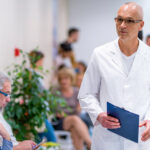While rheumatologists may report less burnout and higher resilience than some medical practitioners, that doesn’t mean there isn’t a problem.
While the latest data shows rheumatologists may be doing “not too badly” when it comes to burnout compared with other medical practitioners, it’s all relative.
Dr Bethan Richards, chief medical wellness officer of the Sydney Local Health District, and head of rheumatology at the Royal Prince Alfred Hospital, told Rheumatology Republic that a recent survey of the 2022 NSW/ACT rheumatology workforce showed that about 46% screened positive for burnout.
“This is consistent with what we are seeing around the world, however what was really striking was how high the rates of burnout were in our trainees,” Dr Richards said.
Seventy-nine percent of doctors in training who responded to the 2022 NSW/ACT Australian Rheumatology Association Wellbeing Survey screened positive for burnout.
“Our data is consistently showing that covid seems to have had a disproportionate impact on trainees” Dr Richards said.
In addition to the constant uncertainty, sense of threat and interruptions felt in day-to-day lives during the pandemic, rheumatology trainees also played a role in the front-line management of covid, while also delivering care virtually to patients with rheumatological issues.
“We asked a lot of our trainees during this time. There were constant workforce shortages and last-minute roster changes, working in PPE was physically demanding, rheumatology training as we knew it was turned on its head. Then at the same time, the in-person support processes we all rely on as doctors to connect and debrief about the day were taken away.”
For consultant rheumatologists, the drivers of distress most frequently reported were heavy administrative loads (including biologic paperwork), lack of locum cover or backfill, excessive work hours, a lack of time to exercise, distressing patient cases, being the subject of a complaint and a feeling that it is impossible to change the system. For those in rural areas, starting out as consultants or in private practice a sense of isolation was also commonly reported as a driver of distress.
“For those in private practice or in remote areas, having a link back to a big centre can provide, not only clinical support and professional development opportunities, but also a level of emotional support as well.”
One particularly vulnerable group of rheumatologists not often discussed are those about to retire, Dr Richards told Rheumatology Republic.
“One of the key issues flagged in the survey was the lack of support for those transitioning into retirement,” she said. “It is not uncommon to see higher rates of depression in this group. Being a doctor is not just a job, it is a vocation to which one’s sense of identity, meaning and purpose is often attached. When you step away from that it can be a difficult transition and leave a void that can be difficult to fill.
“We put a lot of effort into supporting our doctors in training, but we have little in place to support the unique needs of those entering retirement.
“In addition to losing a sense of identity, there are the challenges of selling or closing a practice, financial and medicolegal implications to be aware of, and rheumatology workforce shortages preventing the smooth transition of a patient’s care.
“You’ve done something for 50 years and suddenly you’re going back to a world without the structure you are used to.”
Currently in Australia there are no program or support structures in place for rheumatologists entering retirement.
“That’s an area we should probably think about addressing as a specialty. Those at the ends of their clinical careers have so much to offer still in terms of wisdom, mentorship and teaching. Finding ways to ease the transition and facilitate involvement in these types of activities could create a win-win for both the individual and our specialty,” said Dr Richards.
The other effect of the covid pandemic on clinician wellbeing has been the moral injury associated with not being able to provide best care.
“For some, treating patients with covid through glass windows and not having family allowed to be with them in their last hours has taken a toll. For others, it may be a delayed diagnosis of cancer, fractures from delayed osteoporotic treatment, or the significant weight gain during lockdowns that has worsened symptoms, disease control and comorbidities.”
“Access to allied health care has been so interrupted during the pandemic and led to our waiting lists times increasing significantly. Access to affordable psychological services remains limited despite a clear and ever-increasing need.
“We have a population that has been through a traumatic experience, so one would expect the prevalence of common comorbidities in our patients such as anxiety, depression and pain conditions such as fibromyalgia will further increase. Our patients need better and more affordable access to these evidence-based support services if we are to deliver best care,” said Dr Richards.
Speaking after a Wild Health webinar which talked about technology to help medical practitioners to regain minutes in their days, Dr Richards said rheumatologists were in a difficult position when it came to technology.
“For people working in the public system it is quite different to the private system,” she told Rheumatology Republic.
“Public system rheumatologists don’t have practice management software – they’re still very much handwriting scripts, handwriting forms and relying on hybrid paper record systems.
“That’s a national problem that we don’t see a quick solution for yet,” Dr Richards said. “People are trying to find workarounds but are currently confined to a hybrid, paper-based, inefficient record systems.
“What we heard loud and clear in the rheumatology survey as much as anything is, people are exhausted and just want time back in their day.
“That’s often to do with a lack of time to participate in wellbeing activities – for example, a lack of time to exercise or spend time with friends and family were reported as a key drivers of distress in rheumatologists.
“How do we give people minutes back in their day? Looking for these efficiencies is a really big factor both in the private and public sector.”
And right now, technology isn’t necessarily helping.
“What it’s currently doing, is actually increasing the amount of work,” said Dr Richards. “Having to login to three different systems to find patient information, then having them time out and require a repeat login and then handwriting scripts, imaging and blood forms adds several minutes to every patient encounter. At the end of a week, that is hours lost in inefficiencies for every single clinician.
“So what we really need is a streamlined, efficient system that connects us all, helps deliver best practice and give clinicians minutes back in their day.”
***
A recording of the Wild Health webinar, A holistic approach to healthcare workforce management, is now available on demand.





